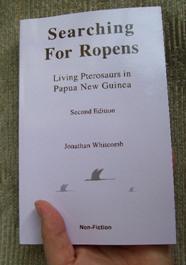|
Searching for Ropens |
|
In the first edition of Searching for Ropens, the index lists seven pages referring to Charles Darwin. None of these contain any criticism of Darwin’s intelligence, but some do find fault with his philosophy of unlimited common ancestry of living organisms.
On page 12, one paragraph explains my doubts about the General Theory of Evolution during my teenage years.
On page 38, another paragraph uses Darwin as an example of how atheism can rob a person of the simple joys of life.
One sentence on page 160 credits Darwin for the idea of universal common ancestry.
One paragraph on page 164 is about the early followers of Darwin. Another paragraph is about how dinosaur and pterosaur fossils seem to support Darwin’s philosophy.
One paragraph on page 172 mentions that, since Darwin, the idea that competition shapes living things has been a popular idea. |
|
On page 173, it reads: “Darwin’s idea about tiny gradual changes eventually adding up to major changes we now know is false. . .”
On page 191, it reads: “The philosophy of Darwin secured dinosaur and pterosaur extinction as supposed evidence for his cause, catapulting the popularity of these extinction ideas.”
One critic of my book (first edition) declares: “The author starts off with a right-wing Christian agenda about how idiotic Darwinism is.” Those who read the book, however, find no word even similar to “idiotic” and no combination of words that could insinuate that Darwin possessed below-average intelligence. Although the foreword and the introduction mention or hint at the conflict between “evolution” and creationism, nothing relates to the word “idiotic,” for this word comes from “idiot,” which refers to someone utterly foolish or senseless. Nothing in my book even hints at the idea that anyone believing in Darwinism is incapable of intelligent thought. |
|
Reply to criticism of the book’s treatment of Charles Darwin |
|
If you have read the book and wish to make comments or suggestions, email to: |
|
The new second edition of Searching for Ropens, at 263 pages, has 17 chapters, 140 images, a 50-page appendix, and a 21-page index.
Although it has no clear photograph of any ropen (such evidence was not available at the date of publication), the book has composite sketches and images of ropen-light apparently caused by intrinsic bioluminescent capability. |
|
Evolution & Pterosaurs |
|
comment[at-sign]searchingforropens.com |
|
From readers of the first edition:
“I read the book cover to cover in the first 48 hours after I received it (it was hard to put down). The author does a great job of laying out the known facts about the Ropen.
“I was equally fascinated with his personal account of summoning up the courage to go on the trip in the first place. The book was as much . . . about finding the courage within you to do something extraordinary as it was about a possible cryptozoological event.”
Alex Aguila, New Hampshire
“I sat up till nearly 4 a.m. reading your book. . . . personally I think you have done a brilliant job of it. Its full of humor and spirituality. Every page was interesting! Your honesty in the book really shone through and it was just such good reading. Loved it!”
Penny, Australia
|
|
Author’s Notes |
|
Read an introduction to bioluminescence; it’s quite a revolutionary characteristic of the creature known in Papua New Guinea as ropen, duwas, seklo-bali, and wawanar.
This living-pterosaur investigation is not a hoax; it is legitimate. |
|
More on Criticisms |
|
The treatment of Charles Darwin in the second edition of the book Searching for Ropens is similar to the treatment in the first edition.
Read how living pterosaurs relate to Darwin’s General Theory of Evolution. |
|
Searching for Ropens Living Pterosaurs in Papua New Guinea
It’s probably the first book ever written about the reports of live “pterodactyls” in the Southwest Pacific. But the strange glowing creatures seen flying around at night are not giant Pterodactyloids, they are giant Rhamphorhynchoids. Amazing as it seems, eyewitness accounts from different cultures agree on a long-tail and no feathers. |


